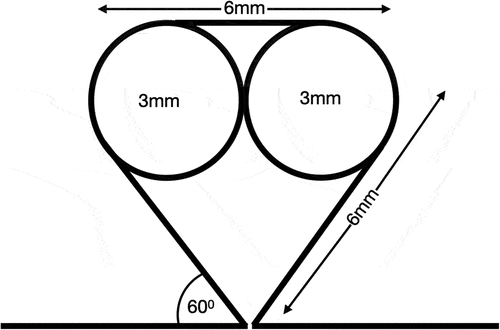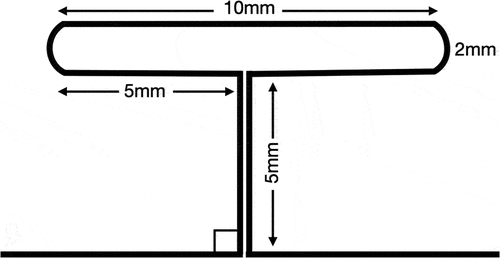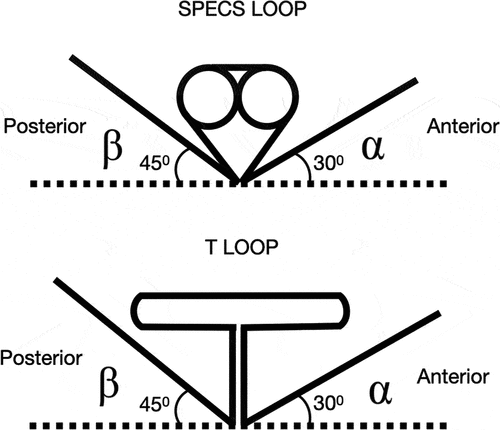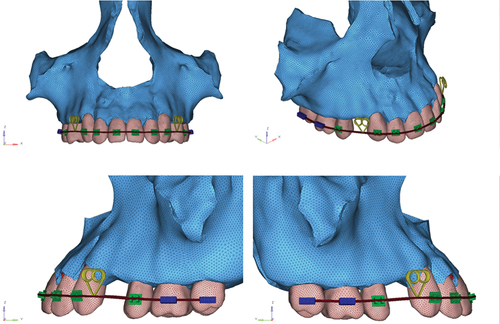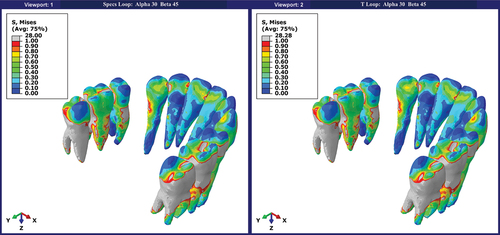ABSTRACT
Purpose
T loop is one of the most commonly used loops for space closure. But the previous literature shows that T loop produces a moment to force ratio of less than the ideal value with high load deflection rate. Thus, a newly designed Specs loop was designed which produced a moment to force ratio of 10:1. The present study was aimed to compare the efficacy of Specs loop and T loop in en-masse anterior retraction.
Materials and Methods
A finite element maxillary model for en-masse anterior retraction was made. The Specs loop and T loop were designed with preactivation bends of 30 degree alpha bend and 45 degree beta bend. The horizontal and vertical forces and moments at both the alpha and beta nodes and overall moment to force ratio, horizontal and vertical movement of crown and root tip of all the individual teeth and stress acting on the teeth and bone were calculated for each loop for a horizontal activation of 3 mm using Abaqus software.
Results
T loop produced a moment to force (M/F) ratio of 9:1, whereas Specs loop produced M/F ratio of 10:1. The Specs loop produced more distal crown tipping of anterior and posterior teeth, whereas the extrusive vertical movement seen was almost the same for both the loops.
Conclusion
Within the limitations of the present study, the Specs loop was more efficient than the T loop for en-masse anterior retraction.
Introduction
Closing loops are most preferred over sliding mechanics in orthodontic space closure due to the two main advantages, namely, their ability to move the teeth without friction and theoretically produce bodily translation of the teeth. The loops have the ability to produce bodily tooth movement if it is capable of producing a moment to force ratio of 10:1 [Citation1]. There are various loops designed for the purpose of orthodontic space closure such as T-loop, mushroom loop, teardrop loop, vertical closing loop, L-loop, opus loop, keyhole loop open-vertical loop and so on [Citation2–5]. Each of these loops has its own advantages and disadvantages, for example, the vertical helical closing loop, T-loop and L-loop have low moment to force (M/F) ratio and high load-deflection (F/D) rate while opus loop without gable bends is said to have a constant and optimum M/F ratio [Citation6,Citation7]. An ideal loop should produce a high M/F ratio with low F/D rate and also should be easy to fabricate [Citation8]. Considering these characteristics, T loop is the most commonly used and studied loop in orthodontics [Citation2–4,Citation8–11]. Although the T loop is commonly used for space closure, it is said to produce a moment to force ratio of less than the optimal value along with a high F/D rate [Citation6,Citation7]. The M/F ratio increases as the height of the T loop is increased [Citation8] but the practical applicability of this modification is limited due to the reduced sulcus depth seen clinically.
To overcome these limitations, a new loop named the Specs loop was designed (). The Specs loop with preactivation bends produced a moment to force ratio of 10:1 with increased anchorage control [Citation12]. Thus, it was decided to compare the efficacy of the Specs loop with that of the most commonly used T loop for en-masse anterior retraction. Since systematic determination of the properties of the loop is not clinically possible, it was decided to use a finite element method (FEM) [Citation13]. The aim of the present FEM study was to compare the efficacy of the Specs loop with that of the T loop in en-masse anterior retraction for an alpha bend of 30 degree and beta bend of 45 degree. The amount of stress, force, moment and moment to force ratio, crown and root movement of all teeth in horizontal and vertical direction were evaluated.
Materials and methods
The maxillary model for retraction was made from the computed tomography (CT) scan. CT scan of human skull was obtained in DICOM format and were transformed into STL images using MIMICS 8.11 software. Stainless steel 0.022 inch slot size MBT brackets were placed on the maxillary teeth and were aligned using a 0.019 × 0.025 inch stainless steel archwire. Maxillary first premolars were removed from both the sides and the space was filled with bone to simulate the movement of en-masse anterior retraction.
The design of the T loop and the Specs loop are represented in , respectively. Both the loops were made of 0.017 × 0.025 inch titanium molybdenum alloy (TMA) wire and preactivation bends of 30 degree alpha bend (anterior) and 45 degree beta bend (posterior) were incorporated ().
The geometric models of the loops with lines and surfaces were made using Solidworks software. The solid geometric model was imported to Abaqus software to make the 3D finite element model and Hypermesh software to create precision (). The material properties of the wire, teeth, bone, periodontal ligament and brackets used for model preparation are mentioned in .
Table 1. Material properties.
The boundary conditions were applied such that the alpha terminal node was restrained in all the three axes while beta node was allowed to move only in the horizontal direction to simulate the movement of wire distally through the molar tube. For insertion of loops with preactivation bends in the model, a fixed point was defined in the beta terminal node simulating the insertion of the wire into the buccal tube. The alpha end was displaced such that the alpha terminal node was at the same vertical level as the bracket slot. The alpha segment crossed the bracket slot at an angle which was proportional to the degree of preactivation bends given. A rotation was added to the alpha end so that the horizontal leg was parallel and in the same line as that of the bracket slot simulating the engagement of the alpha segment of the wire into the bracket slot. The amount of displacement of the alpha node was calculated to obtain information about the crossover produced will engage the wire and the forces and moments produced at both the terminal nodes were calculated.
The horizontal and vertical forces and moments at both the alpha and beta nodes and overall moment-to-force ratio, movement of crown and root in the horizontal and vertical direction of all the individual teeth, stress acting on the teeth and bone were calculated after activating the loops horizontally. Both the loops were positioned 2 mm distal to the canine (i.e., approximately 90% anterior to the extraction space) and were subjected to a horizontal activation of 3 mm. The analyses were done using Abaqus software.
Results
The von Mises stress acting on the teeth and bone are represented in , respectively. The maximum amount of stress was observed in the posterior alveolar region and the roots of the maxillary molars. The maximum stress exerted on the bone and teeth by the T loop was 7.24MPa & 28.28 MPa, respectively, while the maximum stress exerted on bone and teeth by the Specs loop was 6.88 MPa and 28 MPa, respectively.
Horizontal and vertical forces and moments acting on the anterior and posterior teeth and overall moment-to-force ratio for both the loops are indicated in . T loop produced more force compared to Specs loop, whereas the moment to force ratio produced was more for Specs loop than T loop.
Table 2. Force, moment and moment to force ration acting on anterior and posterior teeth.
The rate of horizontal and vertical movement of the crown and root of all the teeth produced by the T loop and the Specs loop are shown in . The Specs loop produced more distal crown tipping of anterior and posterior teeth. The extrusive vertical movement of the anterior teeth was marginally less and that of the posterior teeth was marginally more for the Specs loop.
Table 3. Crown tip, root tip and vertical movements of individual teeth.
Discussion
The present study was aimed to compare the efficacy of the T loop and the Specs loop in en-masse anterior retraction. The efficacy of a closing loop lies in its ability to produce bodily movement by incorporating less force and more moment. The force and moment exerted by the loop depends upon the properties of the archwire material, length of the loop, and range of horizontal activation of the loop [Citation8,Citation14]. The new Specs loop was designed with the idea of increasing the length of the wire incorporated in the loop and also a framework that can be easily fabricated. It was an equilateral triangle with two helices on its base (). The clinical skill and the time taken for the fabrication of the loop was the same as that of the T loop as it involved only two simple helices. The Specs loop produced a force of 200 g and a moment to force ratio of 10:1 with preactivation bends. As the beta bend in the Specs loop increased the extrusive movement of the anteriors decreased while that of the posteriors increased helping in maintaining or opening the bite of the patient during retraction [Citation12]. The total length of the wire incorporated in this loop was approximately 43 mm, whereas the length of the wire incorporated in the T loop was approximately 36 mm. Therefore, theoretically it was hypothesized that the Specs loop will produce less force and more moment to force ratio than the T loop due to the incorporation of more length of wire. This hypothesis was proven in the present FEM study.
The stress and the force exerted by the Specs loop was less than that of the T loop. Horizontal force of 158 g and 178 g was exerted on the anterior teeth by the Specs loop and the T loop, respectively. This shows that the force exerted by the Specs loop was equivalent to the ideal retractive force of 150 g for the anterior teeth. An anterior moment to force ratio of ~9:1 was produced by the T loop, whereas the Specs loop produced a M/F ratio of ~10:1. A similar M/F ratio for T loop was also obtained by Kuhlberg et al [Citation2]. In other recent FEM studies, a M/F ratio of 7.2 and 13.4 was observed for T loop without preactivation bends and with preactivation bends of 10 degrees, respectively. The T loop was fabricated using a 0.016 × 0.022 inch stainless steel archwire and the horizontal activation of the loop was limited to 1 mm [Citation3]. Similarly, a T loop made of 0.019 × 0.025 inch stainless wire incorporating an alpha bend of 15 degree, beta bend of 30 degree and horizontal activation of 1 mm produced a M/F ratio of 7.9 [Citation4]. This shows that the M/F ratio of the T loop can be increased by incorporating preactivation bends and reducing the amount of horizontal activation. But reducing the amount of horizontal activation of the loop will lead to increased treatment duration and patient visits for activation of the loop. Therefore, it can be said that the Specs loop which is capable of producing a M/F ratio of 10:1 for a horizontal activation of 3 mm is efficient in achieving the desired tooth movement with decreased treatment duration and patient visits.
Distal crown tipping and mesial root tipping along with mild extrusive movement for all the teeth were seen in both the loops while the rate of retraction of the anteriors was more in Specs loop. The amount of crown and root movement shows that the Specs loop was also efficient in correcting the axial inclination of the incisors. The anchorage control was also more in Specs loop with more distal tipping of posteriors than the T loop. Similarly, the extrusive movement of the posterior teeth were more and that of the anterior teeth were less in Specs loop compared to the T loop, counteracting the bite deepening effect seen during en masse anterior retraction. Thus, the Specs loop was more efficient than the T loop in en-masse anterior retraction with increased horizontal and vertical anchorage control.
The force, stress and M/F ratio of loops depends not only on the design of the loop but also on the material of the archwire, dimension of the archwire, range of horizontal activation and the degree of preactivation bends [Citation8,Citation14]. Therefore in the present study, all the factors mentioned above other than the design of the loop were kept constant for both the loops. The material of the loop, the amount of preactivation bends and the amount of horizontal activation of the loop were decided based on the previous literature [Citation12].
The limitation of the study was that it was a FEM study and the FEM model cannot ideally replicate the biological changes taking place in an individual. The histological changes taking place after application of orthodontic force will vary among different individuals. Moreover, the type of tooth movement not only depends on the moment to force ratio but also on the location of centre of resistance of the tooth which depends on the length of the root, number of roots and the level of alveolar bone support available which are subjected to high variability.
Conclusion
Within the limitations of the present study, the Specs loop was more efficient than the T loop for en-masse anterior retraction.
Author contributions
Author 1 contributed to design, data acquisition, interpretation of results and drafted the manuscript.
Author 2 contributed to conception and critically revised the manuscript.
Ethical approval
The study was approved by the Institutional Review Board (SRB/SDC/ORTHO-1801/20/037).
Acknowledgments
We sincerely thank Mr. Ramkumar Murugan, CAE specialist, for helping us with the finite element model set up and analysis.
Disclosure statement
No potential conflict of interest was reported by the author(s).
Additional information
Funding
References
- Burstone CJ. The segmented arch approach to space closure. Am J Orthod. 1982;82:361–378.
- Kuhlberg AJ, Burstone CJ. T-loop position and anchorage control. Am J Orthod Dentofacial Orthop. 1997;112:12–18.
- Safavi MR, Geramy A, Khezri AK. M/F ratios of four different closing loops: 3D analysis using the finite element method (FEM). Aust Orthod J. 2006;22:121–126.
- Kamisetty SK, Raghuveer N, Rajavikram N, et al. Evaluation of effects and effectiveness of various α and β angulations for three different loop made of stainless steel arch wires - A FEM study. J Clin Diagn Res. 2014;8:ZC33–7.
- Patel AS, Ravindranath VK, Karandikar GR, et al. Comparative assessment of efficacy of four different designs of retraction loops made of beta titanium archwire: a finite element study. J Contemp Dent. 2014;4:6.
- Siatkowski RE. Continuous arch wire closing loop design, optimization, and verification. Part I. Am J Orthod Dentofacial Orthop. 1997;112:393–402.
- Siatkowski RE. Continuous arch wire closing loop design, optimization, and verification. Part II. Am J Orthod Dentofacial Orthop. 1997;112:487–495.
- Cai Y. Finite element analysis of archwire parameters and activation forces on the M/F ratio of vertical, L- and T-loops. BMC Oral Health. 2020;20:70.
- Chacko A, Tikku T, Khanna R, et al. Comparative assessment of the efficacy of closed helical loop and T-loop for space closure in lingual orthodontics—a finite element study. Prog Orthod. 2018;19:14.
- Rose D, Quick A, Swain M, et al. Moment-to-force characteristics of preactivated nickel-titanium and titanium-molybdenum alloy symmetrical T-loops. Am J Orthod Dentofacial Orthop. 2009;135:757–763.
- Kuhlberg AJ. Force systems from T-loop orthodontic space closure springs: the effects of asymmetric placement and angulation on the alpha-beta moment differential. SoDM Masters Theses. 1992;73.
- Murugesan A, Navaneethan R. A newly designed loop for en-masse anterior retraction - a finite element study. Orthod Waves. 2021; 80:143–8.
- Vikram NR, Hashir YM, Karthikeyan MK. Finite element method in orthodontics. Indian J Multidiscip Dent. Chennai. 2010;1:40–46.
- Choy KC, Kim KH, Park YC. Factors affecting force system of orthodontic loop spring. Korean J Orthod. 1999;29:511–519.

